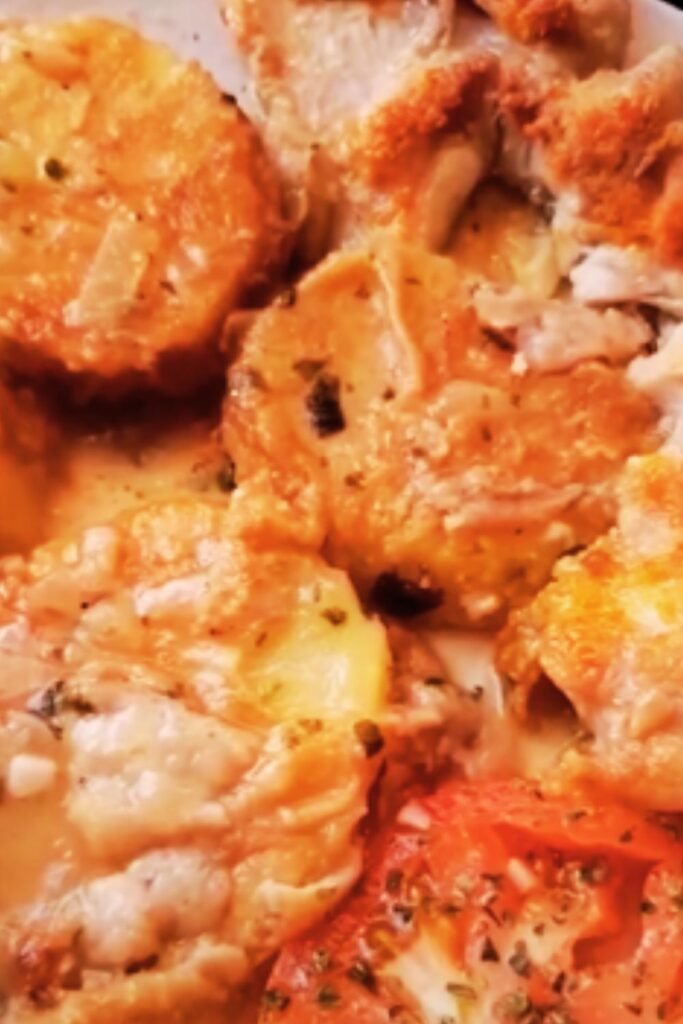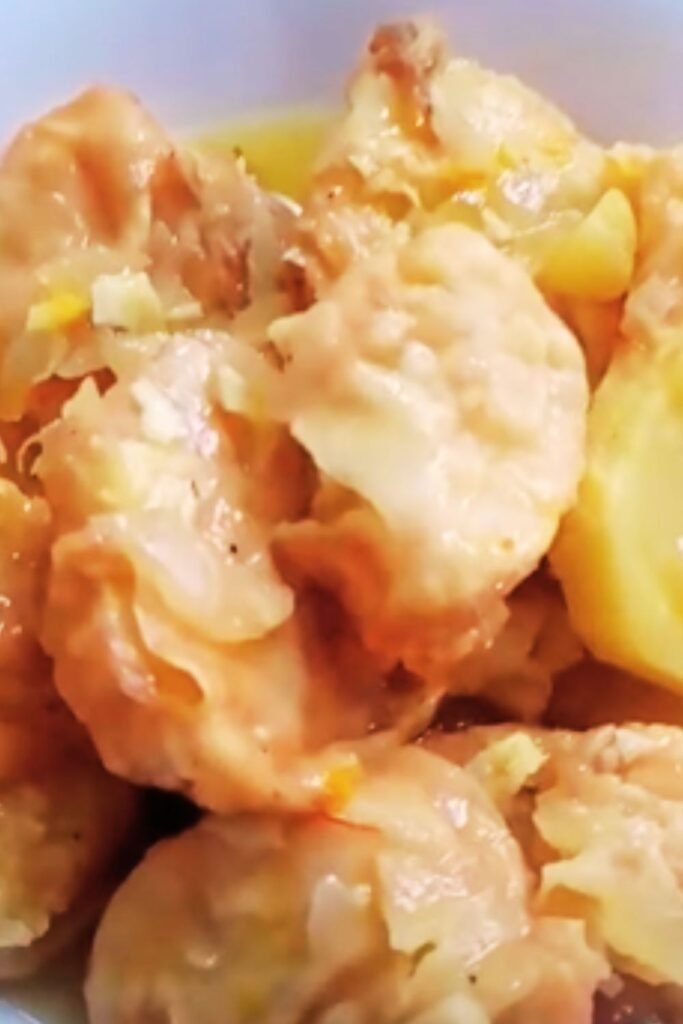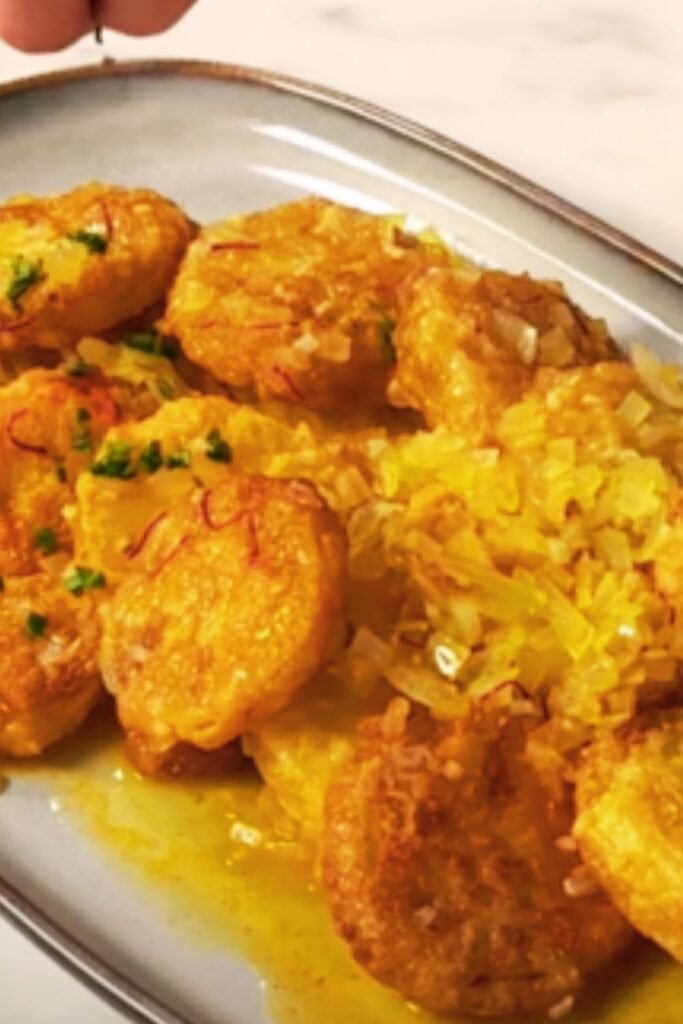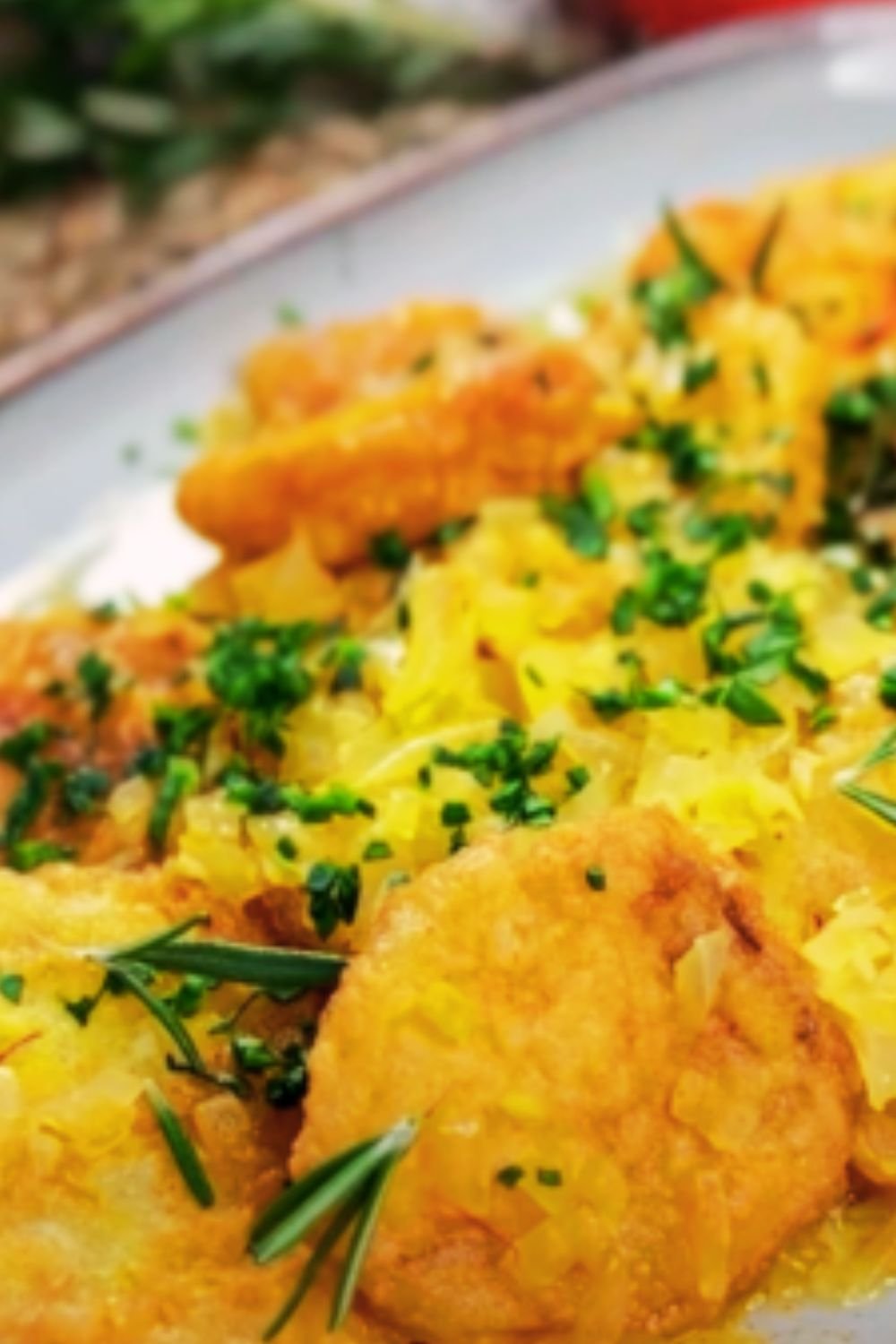Introduction
There’s something deeply satisfying about discovering a dish that transforms humble ingredients into something extraordinary. Patatas a la Importancia is precisely that kind of culinary marvel—a traditional Spanish recipe that elevates the potato from simple side dish to the star of the show. As I’ve explored the rich tapestry of Spanish cuisine over the years, this particular dish has captured my heart with its perfect balance of comforting familiarity and sophisticated flavor.
When I first encountered Patatas a la Importancia in a small family-run restaurant in Madrid, I was immediately struck by its deceptive simplicity. Tender potato slices bathed in a golden sauce with subtle hints of saffron and white wine, all brought together with a technique that gives the dish its characteristic velvety texture. The name itself—”Potatoes of Importance”—hints at the reverence Spaniards have for this preparation, transforming an everyday vegetable into something worthy of celebration.
In this article, I’ll share everything I’ve learned about this classic dish—from its fascinating historical roots to the step-by-step techniques that will help you master it in your own kitchen. I’ll also explore regional variations and offer serving suggestions that will help you create a truly authentic Spanish dining experience at home. Whether you’re a seasoned cook looking to expand your repertoire or simply someone who appreciates the magic of transforming simple ingredients, this guide to Patatas a la Importancia promises to enrich your culinary knowledge and inspire your next cooking adventure.
The History and Cultural Significance
Patatas a la Importancia has deep roots in Spanish culinary tradition, dating back to the 19th century. The dish originated in Madrid during a time when potatoes were still gaining acceptance in European cuisine. Having been introduced from the Americas in the 16th century, potatoes were initially regarded with suspicion and primarily used as animal feed or grown as ornamental plants.
As economic hardships swept through Spain, particularly during periods of war and famine, resourceful home cooks began creating dishes that could transform affordable ingredients into meals worthy of more prosperous times. Patatas a la Importancia emerged from this necessity—a dish that could make humble potatoes seem luxurious and “important,” hence the name.
What makes this dish particularly fascinating is how it reflects the Spanish approach to cooking—elevating simple ingredients through technique and patience. The flour-coated potatoes, fried to golden perfection and then slow-cooked in a flavorful sauce, represented a way to bring dignity to the table even in challenging times.
In traditional Spanish households, Patatas a la Importancia was often served as a main course for family meals, particularly on Fridays when Catholic traditions called for meat-free dishes. Today, it remains a beloved comfort food that speaks to Spain’s resourceful culinary heritage and the importance of making every meal special, regardless of economic circumstances.
The dish also showcases the regional cooking styles of central Spain, particularly Castilian cuisine, which is characterized by straightforward preparations that let quality ingredients shine. While coastal regions of Spain might focus on seafood and Mediterranean flavors, this hearty potato dish exemplifies the robust, satisfying cooking style of Spain’s interior.
Essential Ingredients
Before diving into the preparation process, let’s explore the key ingredients that give Patatas a la Importancia its distinctive character:
Key Ingredients Table
| Ingredient | Quantity | Notes on Selection |
|---|---|---|
| Potatoes | 2 pounds (900g) | Yukon Gold or similar waxy potatoes that hold their shape when cooked |
| All-purpose flour | 1 cup (120g) | For dredging the potatoes before frying |
| Eggs | 2 large | Beaten for coating the potatoes |
| Olive oil | 1 cup (240ml) | Extra virgin for frying and sauce preparation |
| Garlic | 4-6 cloves | Fresh, peeled and finely minced |
| Onion | 1 medium | Yellow or Spanish, finely diced |
| White wine | 1 cup (240ml) | Dry white wine, preferably Spanish Albariño or Verdejo |
| Chicken or vegetable broth | 2 cups (480ml) | Homemade preferred for better flavor |
| Bay leaves | 2 leaves | Fresh or dried for aromatic depth |
| Saffron threads | 1 pinch (about 20 threads) | Spanish saffron for authentic color and flavor |
| Sweet paprika | 1 tablespoon | Spanish pimentón dulce if available |
| Fresh parsley | ¼ cup (15g) | Finely chopped for garnish |
| Salt | To taste | Sea salt preferred |
| Black pepper | To taste | Freshly ground |
| Lemon | 1 medium | For juice and zest (optional) |
Ingredient Deep Dive
- Potatoes: The foundation of this dish. While traditionally made with medium-starch potatoes native to Spain, Yukon Gold varieties make an excellent substitute. Their waxy texture ensures they won’t fall apart during the cooking process while still absorbing the flavorful sauce.
- Saffron: This precious spice gives the dish its characteristic golden hue and distinctive floral aroma. While authentic Spanish saffron is ideal, I’ve found that even a small amount can infuse the entire dish with its magic. To maximize its impact, crush the threads and steep them in a tablespoon of warm water before adding to the sauce.
- Paprika: Spanish paprika (pimentón) comes in several varieties. The sweet version (dulce) provides earthy depth without overwhelming heat, though some regional variations incorporate the smoky (ahumado) or spicy (picante) versions for added character.
- White Wine: Acts as a deglazing agent and adds bright acidity to balance the rich sauce. Spanish white wines like Albariño bring authentic regional flavor, but any dry white wine will work in a pinch.
- Eggs and Flour: These create the distinctive coating that gives the potatoes their luxurious texture—crisp after frying but delightfully tender after simmering in the sauce.

Traditional Preparation Method
Creating authentic Patatas a la Importancia requires attention to detail and a sequence of specific techniques. Here’s my comprehensive breakdown of the traditional preparation method:
Preparation Steps
- Prepare the potatoes:
- Peel the potatoes and cut them into uniform slices approximately ½ inch (1.2 cm) thick.
- Rinse the sliced potatoes under cold water to remove excess starch.
- Pat them dry thoroughly with paper towels to ensure proper coating and frying.
- Create the coating station:
- Place the flour in a shallow dish and season generously with salt and pepper.
- Beat the eggs in a separate bowl until smooth.
- Coat the potatoes:
- Dredge each potato slice in the seasoned flour, ensuring complete coverage.
- Dip the floured potato slice into the beaten egg mixture.
- Return the potato to the flour for a second light coating. This double-coating technique creates the dish’s signature texture.
- Fry the potatoes:
- Heat olive oil in a large, deep skillet until it reaches about 350°F (175°C)—hot enough that a drop of batter immediately sizzles.
- Carefully add the coated potato slices in small batches, being careful not to overcrowd the pan.
- Fry until golden brown on both sides, approximately 2-3 minutes per side.
- Transfer to a paper towel-lined plate to drain excess oil.
- Prepare the sauce base:
- In a separate large, deep pan, heat 3 tablespoons of olive oil over medium heat.
- Add the finely diced onion and sauté until translucent, about 5 minutes.
- Add the minced garlic and cook for another minute until fragrant.
- Sprinkle in the paprika and stir quickly to prevent burning.
- Pour in the white wine and allow it to bubble vigorously, scraping any browned bits from the bottom of the pan.
- Create the saffron infusion:
- In a small bowl, crush the saffron threads between your fingers.
- Add 2 tablespoons of hot water or broth and let steep for 5 minutes.
- Complete the sauce:
- Add the chicken or vegetable broth to the pan with the wine reduction.
- Pour in the saffron infusion, including all the liquid.
- Add the bay leaves and bring the mixture to a gentle simmer.
- Season with salt and freshly ground black pepper to taste.
- Combine and simmer:
- Carefully arrange the fried potato slices in the simmering sauce.
- Cover the pan and reduce heat to low.
- Allow the potatoes to cook gently in the sauce for 25-30 minutes, occasionally spooning the sauce over the potatoes.
- The potatoes should become tender but still hold their shape, and the sauce should thicken slightly.
- Final touches:
- If the sauce is too thin after cooking, increase heat slightly and simmer uncovered for a few minutes.
- For extra richness, some traditional recipes call for stirring in a small amount of additional beaten egg at the end, creating subtle strands throughout the sauce.
- Taste and adjust seasonings as needed.
- Serve:
- Remove the bay leaves.
- Transfer to a serving dish and garnish with freshly chopped parsley.
- Optionally, add a light squeeze of lemon juice for brightness.
Critical Technique Tips
- Temperature control is crucial: When frying the potatoes, maintain the oil at a consistent temperature. Too hot, and the coating will burn before the potatoes cook; too cool, and they’ll absorb excess oil.
- Gentle simmering: The final cooking stage should be done at a bare simmer. Vigorous boiling can break apart the potatoes and their delicate coating.
- Rest before serving: Allow the dish to rest for 5-10 minutes off the heat before serving. This helps the flavors meld and the sauce reach the perfect consistency.

Regional Variations
Like many traditional dishes, Patatas a la Importancia has evolved differently across various regions of Spain, each adding local ingredients or techniques. Understanding these variations can provide inspiration for your own interpretations:
Madrid Style (Classic Version)
The version I’ve outlined above most closely represents the traditional Madrid preparation, which features a saffron-infused sauce with minimal additions. This preparation highlights the potatoes themselves and the silky sauce, reflecting the straightforward cooking style of Spain’s capital region.
Andalusian Variation
In southern Spain, particularly in Andalusia, the dish often incorporates more robust flavors:
- Additional sweet and smoky paprika gives the sauce a deeper red color
- Minced red bell peppers are added to the sauce base
- Sometimes includes serrano ham bits for savory depth
- More garlic is typically used
- Occasionally finished with a splash of sherry vinegar instead of lemon
Northern Spanish Adaptation
In the north, particularly in regions like Asturias and Galicia:
- The sauce often includes a small amount of tomato paste or puree
- Fresh herbs like thyme join the traditional parsley
- Sometimes incorporates local cider instead of white wine
- May include regional additions like clams or chunks of salt cod
- Tends to have a slightly thinner, more broth-like sauce
Modern Interpretations
Contemporary Spanish chefs have been reimagining this classic dish in creative ways:
- Adding roasted red peppers or piquillo peppers to the sauce
- Incorporating sautéed mushrooms for umami depth
- Using specialized potato varieties like the purple-hued Vitelotte
- Creating vegetarian versions using mushroom broth enhanced with smoked paprika
- Finishing with artisanal olive oils infused with herbs or citrus
I’ve experimented with several of these variations in my own kitchen and found that while the classic version remains unbeatable for its elegant simplicity, adding small touches—like a handful of fresh peas in springtime or a sprinkle of smoked paprika—can create delightful seasonal adaptations without compromising the dish’s essential character.
Nutritional Information
For those mindful of nutritional content, here’s a breakdown of what you can expect from a typical serving of Patatas a la Importancia:
Nutritional Values Table
| Nutrient | Amount per Serving | % Daily Value* |
|---|---|---|
| Calories | 385 | – |
| Total Fat | 18g | 23% |
| Saturated Fat | 3g | 15% |
| Trans Fat | 0g | – |
| Cholesterol | 93mg | 31% |
| Sodium | 480mg | 21% |
| Total Carbohydrates | 45g | 16% |
| Dietary Fiber | 4g | 14% |
| Sugars | 3g | – |
| Protein | 8g | 16% |
| Vitamin A | – | 15% |
| Vitamin C | – | 45% |
| Calcium | – | 4% |
| Iron | – | 10% |
| Potassium | – | 18% |
*Based on a 2,000 calorie diet. Values are approximate and may vary based on specific ingredients and preparation methods.
Health Considerations
While Patatas a la Importancia is traditionally prepared with generous amounts of olive oil for frying, there are several ways to adapt the recipe for different dietary needs:
- Reduced fat version: The potatoes can be oven-baked after coating rather than fried. While this alters the authentic texture somewhat, it significantly reduces the oil content while maintaining much of the flavor profile.
- Gluten-free adaptation: The wheat flour can be replaced with a gluten-free alternative such as rice flour or a gluten-free all-purpose blend. This substitution works remarkably well and is barely noticeable in the final dish.
- Lower sodium option: Reducing salt and using low-sodium broth can make this dish more suitable for those monitoring sodium intake. The saffron and wine provide enough flavor complexity that the dish remains delicious even with less salt.
- Nutritional benefits: Despite its indulgent reputation, this dish offers several nutritional advantages:
- Potatoes provide a good source of vitamin C, potassium, and vitamin B6
- The olive oil contains heart-healthy monounsaturated fats
- Garlic and onions offer immune-supporting compounds
- Saffron contains antioxidants and has been studied for potential mood-enhancing properties
Serving Suggestions
Patatas a la Importancia can be presented as either a hearty main dish or a substantial side. Here are my favorite serving suggestions that complement its rich flavors:
As a Main Course
When serving as a main dish, I recommend:
- Accompanying with a simple green salad dressed with a light vinaigrette to balance the richness
- Serving alongside sautéed seasonal vegetables such as asparagus, broccolini, or green beans
- Offering crusty bread to soak up the delicious sauce
- Garnishing with extra fresh herbs like parsley and a wedge of lemon
- Portion size for a main course should be approximately 1.5-2 cups per person
As a Side Dish
When serving as an accompaniment:
- Pairs beautifully with simply prepared white fish such as hake or cod
- Complements roasted chicken with herbs
- Works wonderfully alongside grilled vegetables and a soft-boiled egg for a vegetarian option
- Serves as an excellent partner to slow-roasted lamb or pork
- Portion size for a side should be approximately 3/4-1 cup per person
Presentation Ideas
For an impressive presentation:
- Serve in a traditional earthenware cazuela for rustic charm
- Arrange the potatoes in a circular pattern with the sauce poured over
- Sprinkle with bright garnishes like finely chopped fresh parsley, thin strips of roasted red pepper, or a few saffron threads
- For special occasions, serve individual portions in small ramekins or gratin dishes
Timing and Temperature
Patatas a la Importancia actually improves when allowed to rest before serving, making it an ideal make-ahead dish:
- The flavors meld beautifully when the dish rests for 15-20 minutes before serving
- It can be gently reheated the next day with excellent results—many Spanish cooks believe it tastes even better on day two
- Serve hot but not scalding, as extreme temperatures can mask the subtle flavors

Common Mistakes and Troubleshooting
Even experienced cooks can encounter challenges when preparing Patatas a la Importancia for the first time. Here are solutions to the most common issues:
Potential Problems and Solutions
Problem: Potato coating falls off during cooking
- Solution: Ensure potatoes are thoroughly dried before coating
- Solution: Let the coated potatoes rest for 5-10 minutes before frying
- Solution: Handle potatoes gently when turning in the oil and when transferring to the sauce
Problem: Sauce is too thin and watery
- Solution: Simmer uncovered for longer to reduce liquid
- Solution: Create a small amount of slurry with 1 teaspoon cornstarch and 1 tablespoon cold water, then stir into the simmering sauce
- Solution: Ensure oil is hot enough when frying potatoes, as proper initial frying helps the coating absorb sauce correctly
Problem: Potatoes are undercooked or overcooked
- Solution for undercooked: Extend the simmering time, checking tenderness every 5 minutes
- Solution for overcooked: Cut potatoes slightly thicker next time (closer to ¾ inch) and reduce simmering time
Problem: Saffron flavor isn’t pronounced
- Solution: Always bloom saffron in hot liquid before adding
- Solution: Crush threads between fingers to release more flavor
- Solution: Consider increasing the amount slightly or ensuring you’re using fresh, high-quality saffron
Problem: Sauce is separating or breaking
- Solution: Keep heat gentle during the entire simmering process
- Solution: If egg is added at the end, temper it first by whisking a small amount of hot sauce into the beaten egg before adding to the pot
- Solution: Avoid vigorous stirring; instead, occasionally shake the pan gently to distribute sauce
Questions and Answers
Q: Can I prepare Patatas a la Importancia in advance?
Absolutely! This dish actually benefits from being made a day ahead. The flavors continue to develop as it rests, and many Spanish cooks insist it tastes even better the second day. Prepare it completely, allow it to cool, and refrigerate. Gently reheat on the stovetop over medium-low heat, adding a splash of broth if needed to loosen the sauce.
Q: Is there a way to make this dish without frying?
Yes, though the texture will be different. For a lightened version, you can coat the potatoes as directed, then arrange them on a parchment-lined baking sheet. Brush or spray with olive oil and bake at 425°F (220°C) until golden brown (about 25-30 minutes), turning halfway through. Then proceed with the sauce steps and final simmering as directed.
Q: Can I substitute another herb or spice for saffron?
While saffron provides the distinctive flavor and color that makes this dish special, you can substitute a pinch of turmeric for color and add a small amount of paprika for flavor complexity. Some home cooks also use a combination of sweet paprika and a tiny pinch of ground cloves to approximate saffron’s unique profile. However, I strongly recommend using real saffron if at all possible, as substitutes significantly alter the authentic character of the dish.
Q: How thick should I slice the potatoes?
For traditional Patatas a la Importancia, aim for slices about ½ inch (1.2 cm) thick. Cutting them too thin (less than ¼ inch) will cause them to fall apart during cooking, while slices thicker than ¾ inch may remain undercooked in the center. Consistency in thickness is key for even cooking.
Q: Why is my sauce turning out an odd color instead of the golden hue I expected?
The beautiful golden color comes primarily from quality saffron. If your sauce lacks the characteristic color, your saffron might be old or of lower quality. Additionally, if you’re using a different type of paprika (particularly the smoky variety), it can shift the color toward a deeper red. For the classic golden hue, use fresh saffron threads and sweet paprika rather than smoked.
Q: My family doesn’t consume alcohol. Can I make this without wine?
Yes, you can substitute the white wine with additional broth plus 1-2 tablespoons of white wine vinegar or fresh lemon juice to provide the acidity that wine would contribute. Some cooks also use alcoholic white grape juice with good results.
Conclusion
Patatas a la Importancia represents everything I love about traditional Spanish cooking—resourcefulness, respect for ingredients, and the transformative power of technique. What begins as humble potatoes becomes an elegant dish worthy of its name through the careful application of time-honored methods.
As I’ve shared this dish with friends and family over the years, I’ve watched their surprise as they discover how something seemingly simple can deliver such complex flavors and satisfying textures. The golden sauce, infused with saffron’s distinctive aroma, the tender potatoes with their velvety coating—these elements come together to create something truly greater than the sum of its parts.
Whether you’re exploring Spanish cuisine for the first time or looking to perfect a dish you’ve enjoyed in restaurants, I encourage you to try this recipe. Don’t be intimidated by the multiple steps; each one builds flavor and contributes to the final result. Take your time, enjoy the process, and remember that dishes like this one have been perfected by generations of home cooks working with basic equipment and simple ingredients.
In our modern world of convenience foods and instant gratification, there’s something profoundly satisfying about connecting with culinary traditions that emphasize patience and care. Patatas a la Importancia reminds us that with attention to detail and respect for technique, even the most everyday ingredients can be transformed into something truly special—something “of importance.”
I hope this detailed guide inspires you to bring this classic Spanish dish to your own table. As they say in Spain before a meal, “¡Buen provecho!”


